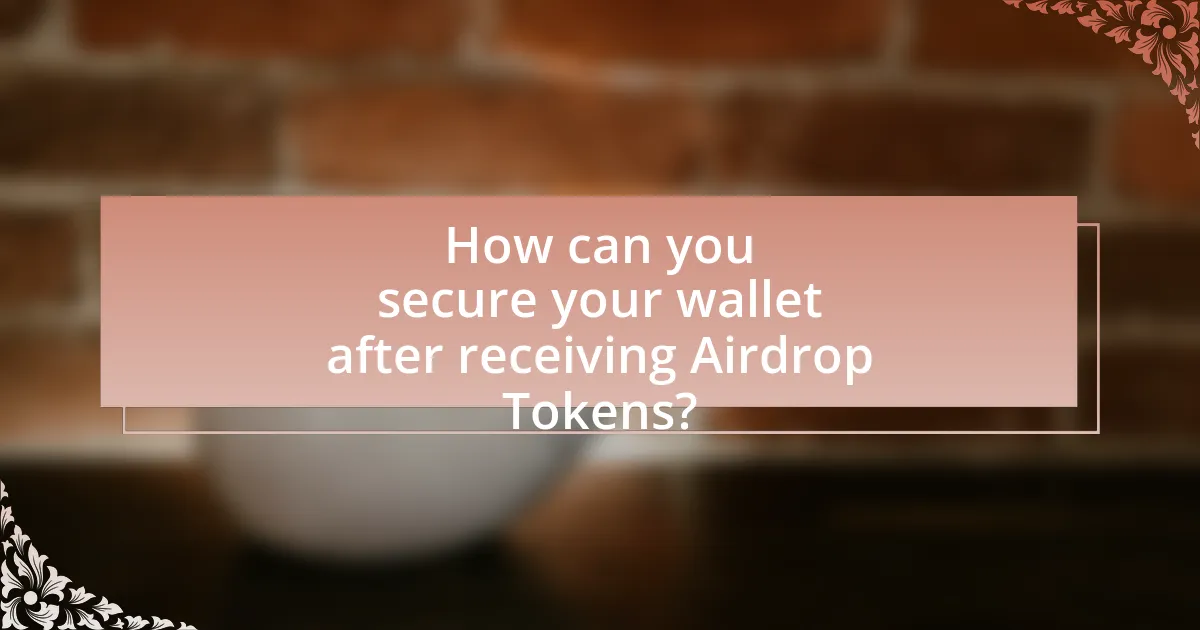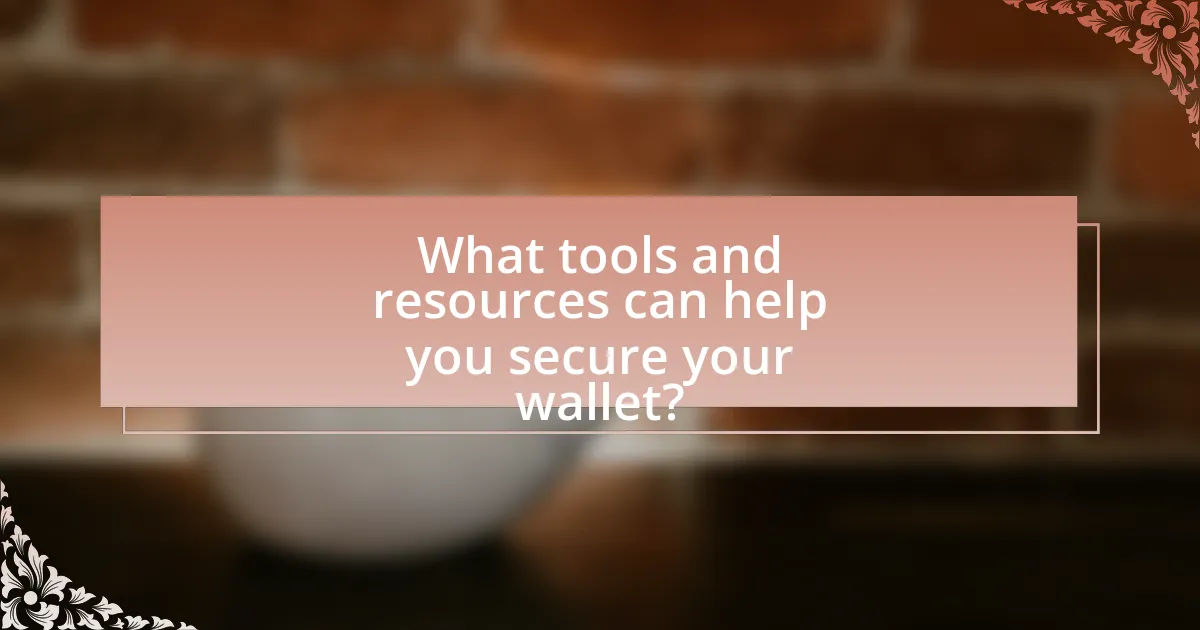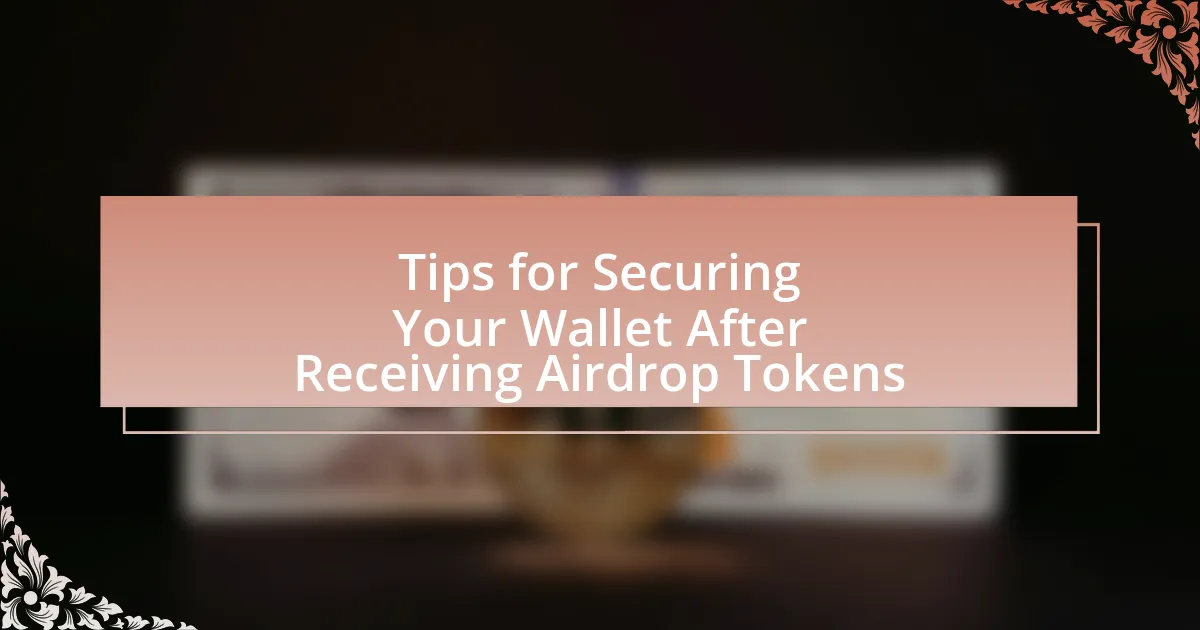Airdrop tokens are free cryptocurrencies distributed to users as part of marketing strategies to promote new projects and enhance community engagement. This article provides essential tips for securing your wallet after receiving airdrop tokens, including methods of distribution, types of airdrops, and associated risks such as scams and security vulnerabilities. It emphasizes the importance of verifying the legitimacy of tokens, transferring them to secure wallets, and implementing robust security measures like two-factor authentication and hardware wallets. Additionally, the article outlines best practices for ongoing wallet security and resources for staying informed about potential threats.

What are Airdrop Tokens and Why are They Important?
Airdrop tokens are cryptocurrencies distributed for free to multiple wallet addresses, often as part of a marketing strategy to promote a new project or increase user engagement. They are important because they can provide users with initial access to a new token, incentivize participation in a blockchain ecosystem, and help projects build a community by distributing tokens widely. For instance, in 2020, the Uniswap platform airdropped 400 UNI tokens to users who had previously interacted with its protocol, which significantly increased user adoption and engagement.
How do Airdrop Tokens work?
Airdrop tokens are distributed by cryptocurrency projects to users, typically for free, as a marketing strategy or to incentivize community engagement. These tokens are sent directly to users’ wallets, often based on criteria such as holding a specific cryptocurrency or participating in a project’s activities. For example, in 2020, Uniswap airdropped its governance token, UNI, to users who had previously interacted with its platform, distributing a total of 1 billion tokens to over 250,000 wallets. This method not only increases awareness of the project but also encourages users to engage with the platform, thereby enhancing its ecosystem.
What are the different types of Airdrop Tokens?
Airdrop tokens can be categorized into several types, including standard airdrops, holder airdrops, and exclusive airdrops. Standard airdrops distribute tokens to a wide audience, often requiring minimal participation, such as signing up for a newsletter. Holder airdrops reward existing holders of a specific cryptocurrency by distributing new tokens based on their current holdings. Exclusive airdrops target specific groups, such as community members or early adopters, often requiring participation in promotional activities or social media engagement. These classifications help users understand the nature of the airdrop and the criteria for receiving tokens.
How are Airdrop Tokens distributed to users?
Airdrop tokens are distributed to users primarily through a process that involves sending cryptocurrency directly to users’ wallets based on specific criteria set by the project. These criteria often include holding a certain amount of a related cryptocurrency, participating in a community event, or completing tasks such as social media engagement. For example, a project may require users to hold a minimum balance of an existing token in their wallet to qualify for the airdrop, ensuring that the distribution targets active participants in the ecosystem. This method of distribution is designed to incentivize user engagement and promote the new token effectively.
What risks are associated with receiving Airdrop Tokens?
Receiving Airdrop Tokens carries several risks, including potential scams, security vulnerabilities, and regulatory issues. Scammers may use airdrops to lure users into providing personal information or private keys, leading to theft of funds. Additionally, airdrop tokens may be associated with projects that lack legitimacy, resulting in loss of investment. Security vulnerabilities can arise if users do not properly secure their wallets, making them susceptible to hacking. Furthermore, regulatory scrutiny may affect the legality of certain airdrop tokens, posing risks to users who may inadvertently violate laws.
How can Airdrop Tokens expose your wallet to security threats?
Airdrop tokens can expose your wallet to security threats primarily through phishing attacks and malicious smart contracts. When users receive airdropped tokens, they may inadvertently interact with fraudulent projects that mimic legitimate ones, leading to the compromise of private keys or sensitive information. For instance, a study by Chainalysis in 2021 revealed that over $2.8 billion was lost to scams, many of which involved deceptive airdrop schemes. Additionally, some airdrop tokens may contain malicious code that, when interacted with, can drain funds from the user’s wallet. This highlights the importance of verifying the legitimacy of airdrop sources before engaging with them.
What common scams should you be aware of when receiving Airdrop Tokens?
Common scams to be aware of when receiving airdrop tokens include phishing attacks, fake airdrop announcements, and wallet draining schemes. Phishing attacks often involve fraudulent emails or messages that mimic legitimate projects, prompting users to provide private keys or sensitive information. Fake airdrop announcements can lure users into providing personal information or sending cryptocurrency to receive tokens that do not exist. Wallet draining schemes may involve malicious contracts that, once interacted with, allow scammers to access and drain the user’s wallet. According to a report by the Blockchain Security Alliance, phishing and scams account for a significant percentage of losses in the cryptocurrency space, highlighting the importance of vigilance when engaging with airdrop offers.

How can you secure your wallet after receiving Airdrop Tokens?
To secure your wallet after receiving airdrop tokens, immediately transfer the tokens to a hardware wallet or a secure wallet that you control. This action minimizes the risk of loss due to hacks or phishing attacks, as hardware wallets store private keys offline, making them less vulnerable to online threats. According to a report by the Cybersecurity & Infrastructure Security Agency, hardware wallets are considered one of the safest options for storing cryptocurrencies, as they provide an additional layer of security compared to software wallets.
What immediate steps should you take after receiving Airdrop Tokens?
After receiving airdrop tokens, the immediate steps to take include verifying the legitimacy of the tokens, transferring them to a secure wallet, and updating your wallet’s security settings. Verifying the legitimacy involves checking the source of the airdrop and ensuring it is from a reputable project to avoid scams. Transferring the tokens to a secure wallet, preferably a hardware wallet, protects them from online threats. Updating your wallet’s security settings, such as enabling two-factor authentication and changing passwords, further enhances security against unauthorized access. These steps are crucial as they mitigate risks associated with potential fraud and hacking incidents in the cryptocurrency space.
How can you verify the legitimacy of the Airdrop Tokens?
To verify the legitimacy of Airdrop Tokens, check the project’s official website and social media channels for announcements and details about the airdrop. Additionally, review the token’s contract address on a blockchain explorer to ensure it matches the one provided by the project. This method is supported by the fact that legitimate projects typically maintain consistent communication and transparency regarding their tokens, while fraudulent airdrops often lack verifiable information or have mismatched contract addresses.
What security settings should you adjust in your wallet?
To enhance the security of your wallet after receiving airdrop tokens, you should adjust settings such as enabling two-factor authentication (2FA), setting a strong and unique password, and regularly updating your wallet software. Two-factor authentication adds an extra layer of security by requiring a second form of verification, significantly reducing the risk of unauthorized access. A strong password, ideally a combination of letters, numbers, and symbols, protects against brute-force attacks. Regular updates ensure that your wallet benefits from the latest security patches and features, which is crucial as vulnerabilities are often discovered over time.
What long-term security practices should you adopt?
To enhance long-term security for your wallet after receiving airdrop tokens, adopt practices such as enabling two-factor authentication (2FA), regularly updating software, and using hardware wallets for storage. Two-factor authentication significantly reduces unauthorized access by requiring a second form of verification, which is crucial for protecting sensitive information. Regular software updates ensure that your wallet benefits from the latest security patches, reducing vulnerabilities. Utilizing hardware wallets, which store private keys offline, provides an additional layer of security against online threats, as they are less susceptible to hacking attempts. These practices are supported by cybersecurity studies indicating that multi-layered security approaches effectively mitigate risks associated with digital asset management.
How can you use hardware wallets for enhanced security?
Using hardware wallets enhances security by storing private keys offline, which protects them from online threats such as hacking and malware. Hardware wallets, like Ledger or Trezor, generate and store cryptographic keys in a secure chip, ensuring that sensitive information never leaves the device. This offline storage significantly reduces the risk of unauthorized access, as the keys are not exposed to the internet. Additionally, hardware wallets often require physical confirmation for transactions, adding another layer of security against remote attacks.
What role does two-factor authentication play in securing your wallet?
Two-factor authentication (2FA) significantly enhances the security of your wallet by requiring two forms of verification before granting access. This additional layer of security mitigates the risk of unauthorized access, as even if a malicious actor obtains your password, they would still need the second factor, typically a code sent to your mobile device or generated by an authentication app, to gain entry. According to a study by Google, implementing 2FA can block 100% of automated bots and 96% of phishing attacks, demonstrating its effectiveness in protecting sensitive information such as wallet credentials.

What tools and resources can help you secure your wallet?
To secure your wallet, utilize hardware wallets, software wallets with strong encryption, and two-factor authentication (2FA) tools. Hardware wallets, such as Ledger and Trezor, store private keys offline, significantly reducing the risk of hacking. Software wallets like Exodus and Atomic Wallet offer user-friendly interfaces and robust security features, including encryption and backup options. Implementing 2FA through applications like Google Authenticator or Authy adds an extra layer of security by requiring a second form of verification during login. These tools collectively enhance wallet security by protecting against unauthorized access and potential theft.
What software solutions are available for wallet security?
Software solutions available for wallet security include hardware wallets, software wallets with encryption, multi-signature wallets, and antivirus software. Hardware wallets, such as Ledger and Trezor, store private keys offline, significantly reducing the risk of hacking. Software wallets like Exodus and Atomic Wallet offer encryption features to protect user data. Multi-signature wallets require multiple approvals for transactions, enhancing security against unauthorized access. Additionally, antivirus software can protect devices from malware that targets wallet applications. These solutions collectively provide robust security measures for safeguarding digital assets.
How can antivirus and anti-malware tools protect your wallet?
Antivirus and anti-malware tools protect your wallet by detecting and removing malicious software that can compromise your financial information. These tools scan for threats such as keyloggers, which capture keystrokes to steal passwords, and phishing software, which attempts to trick users into revealing sensitive data. According to a report by Cybersecurity Ventures, cybercrime is projected to cost the world $10.5 trillion annually by 2025, highlighting the importance of robust security measures. By regularly updating and running antivirus and anti-malware software, users can significantly reduce the risk of unauthorized access to their wallets and financial accounts.
What are the best practices for using wallet security tools?
The best practices for using wallet security tools include enabling two-factor authentication (2FA), regularly updating wallet software, and using hardware wallets for enhanced security. Two-factor authentication adds an extra layer of protection by requiring a second form of verification, significantly reducing the risk of unauthorized access. Regular software updates ensure that any vulnerabilities are patched, keeping the wallet secure against emerging threats. Hardware wallets, which store private keys offline, provide a robust defense against online attacks, making them a preferred choice for storing significant amounts of cryptocurrency. These practices are supported by cybersecurity experts who emphasize the importance of multi-layered security approaches in protecting digital assets.
How can you stay informed about wallet security threats?
To stay informed about wallet security threats, regularly follow reputable cryptocurrency news websites and security blogs. These sources often provide timely updates on vulnerabilities, scams, and best practices for securing digital wallets. For instance, websites like CoinDesk and CoinTelegraph frequently publish articles on emerging threats and security advisories. Additionally, subscribing to alerts from cybersecurity firms, such as Kaspersky or McAfee, can provide insights into the latest security trends and threats specific to cryptocurrency wallets. Engaging with community forums, such as Reddit or specialized Discord channels, can also help users share experiences and warnings about potential security issues.
What online communities and resources provide updates on security threats?
Online communities and resources that provide updates on security threats include cybersecurity forums, threat intelligence platforms, and social media groups focused on security. Notable examples are the r/netsec subreddit, which shares real-time security news and discussions, and platforms like Threatpost and Krebs on Security, which publish articles on the latest vulnerabilities and threats. Additionally, organizations such as the Cybersecurity and Infrastructure Security Agency (CISA) offer alerts and updates on emerging threats, making them reliable sources for current security information.
How can you educate yourself about the latest security practices?
To educate yourself about the latest security practices, regularly follow reputable cybersecurity blogs, attend webinars, and participate in online courses focused on security. For instance, resources like the Cybersecurity & Infrastructure Security Agency (CISA) provide up-to-date information on security threats and best practices. Additionally, platforms such as Coursera and Udemy offer courses on cybersecurity fundamentals, which can enhance your understanding of current security measures. Engaging with professional communities on forums like Reddit or LinkedIn can also provide insights into emerging security trends and practices.
What are the best practices for securing your wallet after receiving Airdrop Tokens?
To secure your wallet after receiving airdrop tokens, immediately transfer the tokens to a hardware wallet or a secure wallet that you control. Hardware wallets, such as Ledger or Trezor, provide offline storage, significantly reducing the risk of hacks or unauthorized access. Additionally, enable two-factor authentication (2FA) on your wallet and associated accounts to add an extra layer of security. Regularly update your wallet software to protect against vulnerabilities, and avoid sharing your private keys or recovery phrases with anyone. These practices are essential as a significant percentage of crypto thefts occur due to compromised wallets, highlighting the importance of robust security measures.

